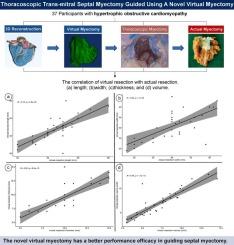应用新型虚拟肌瘤切除术指导胸腔镜下肥厚性梗阻性心肌病患者的肌瘤切除术
IF 2.5
Q2 CARDIAC & CARDIOVASCULAR SYSTEMS
引用次数: 0
摘要
背景:本研究旨在评估一种新型虚拟肌瘤切除术在指导胸腔镜经二尖瓣肌瘤切除术中的效果。方法和结果回顾性分析2019年4月至2021年10月37例胸腔镜下经二尖瓣间隔肌切除术引导下虚拟肌切除术患者的临床资料。将增强心脏CT图像导入Mimics软件进行虚拟肌瘤切除术。垂直于室间隔(IVS)的短轴双室平面,标记了从室间隔基部到鼻尖的每段。连续测量每个标记段的IVS厚度,并通过图形化的数字模型确定切除程度。该队列包括22名女性(59.46%),平均年龄为53.14±13.62岁。没有发生死亡或永久性心脏起搏器植入。鼻中隔厚度由20.49±3.85 mm降至11.28±2.53 mm (P < 0.001),导致阻塞明显减少(90.84±28.78降至11.59±11.06 mmHg, P < 0.001)。12例(32.43%)行二尖瓣置换术。虚拟切除的长度、宽度、厚度和体积与实际切除呈强正相关(R = 0.76-0.89)。虚拟模型的间隔厚度与实际切除体积有中度相关性(R = 0.51, P < 0.01)。结论虚拟肌瘤切除术能有效指导中隔肌瘤切除术,对部分患者疗效良好。这种方法与术前3D模拟和打印相结合,可以对复杂病例进行精确规划。本文章由计算机程序翻译,如有差异,请以英文原文为准。

Use of the novel virtual myectomy in guiding thoracoscopic myectomy for patients with hypertrophic obstructive cardiomyopathy
Background
This study aimed to evaluate the efficacy of a novel virtual myectomy procedure in guiding thoracoscopic trans-mitral myectomy.
Methods and Results
Clinical data from 37 patients who underwent thoracoscopic trans-mitral septal myectomy guided by virtual myectomy between April 2019 and October 2021 were retrospectively analyzed. Enhanced cardiac CT images were imported into Mimics software to perform virtual myectomy. The short-axis two-chamber plane, perpendicular to the interventricular septum (IVS), was marked for each segment from the basal septum to the apex. IVS thickness was continuously measured at each marked segment, and a figurative digital model determined the resection extent. The cohort consisted of 22 women (59.46 %) with a mean age of 53.14 ± 13.62 years. No deaths or permanent pacemaker implantations occurred. Septal thickness decreased significantly from 20.49 ± 3.85 to 11.28 ± 2.53 mm (P < 0.001), resulting in a marked reduction in obstruction (90.84 ± 28.78 to 11.59 ± 11.06 mmHg, P < 0.001). Twelve patients (32.43 %) underwent mitral valve replacement. The virtual resection’s length, width, thickness, and volume showed strong positive correlations with the actual resection (R = 0.76–0.89). The virtual model’s septal thickness was moderately correlated with the actual resection volume (R = 0.51, P < 0.01).
Conclusions
Virtual myectomy effectively guided septal myectomy, with favorable outcomes in selected patients. This approach, combined with preoperative 3D simulation and printing, enables precise planning for complex cases.
求助全文
通过发布文献求助,成功后即可免费获取论文全文。
去求助
来源期刊

IJC Heart and Vasculature
Medicine-Cardiology and Cardiovascular Medicine
CiteScore
4.90
自引率
10.30%
发文量
216
审稿时长
56 days
期刊介绍:
IJC Heart & Vasculature is an online-only, open-access journal dedicated to publishing original articles and reviews (also Editorials and Letters to the Editor) which report on structural and functional cardiovascular pathology, with an emphasis on imaging and disease pathophysiology. Articles must be authentic, educational, clinically relevant, and original in their content and scientific approach. IJC Heart & Vasculature requires the highest standards of scientific integrity in order to promote reliable, reproducible and verifiable research findings. All authors are advised to consult the Principles of Ethical Publishing in the International Journal of Cardiology before submitting a manuscript. Submission of a manuscript to this journal gives the publisher the right to publish that paper if it is accepted. Manuscripts may be edited to improve clarity and expression.
 求助内容:
求助内容: 应助结果提醒方式:
应助结果提醒方式:


